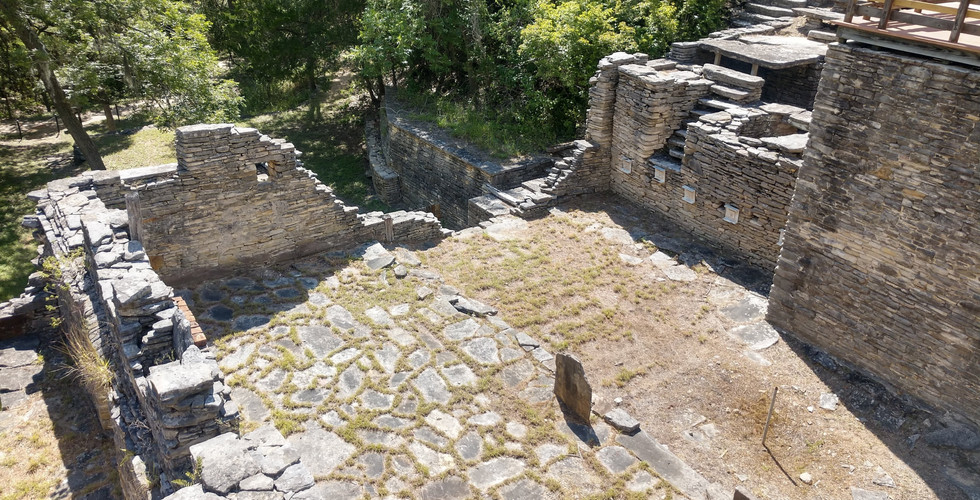
Growing up, I used to go with my parents and sister to Corpus Christi to visit my aunt, uncle and cousin in the summer. Once I could drive myself, I continued the tradition, and would always take Highway 77 from Waco south, rather than the faster I35. It took a little longer to go that way, but it was fun to go through all the little towns: Rosebud, Lexington, Schulenburg, Hallettsville and so on. Plus that way I got to arrive in Corpus over the Bay Bridge.
One of my favorite stretches was a squiggly little piece of road just outside of La Grange. This is right where the Oakville Escarpment marks a major geologic shift, and the land rises about 150 feet over a quarter of a mile so the road switches back and forth for the climb.
I always knew when the squiggly part was coming when heading north toward home because of a sign pointing to the Kreische Brewery. I thought it was curious that the highway department would put up a sign pointing to a brewery, but was usually too pooped from partying on the beach and ready to get home, so never turned off the road to check it out.
That changed back in the 80's when some friends and I were gallivanting around that part of the state. We had just been to the Shiner brewery, so I guess we were on a sort of mini beer tour. Anyway, we got the idea to check out Kriesche, since La Grange was only about an hour away.
Folks, keep in mind I had no idea what this was all about. I wasn't the student of Texas History I later came to be, and thought we were just going to check out another brand of the cold stuff. Imagine my surprise when we stepped out of the truck to find not only the ruins of a 120 year old brewery, but also a monument to an important part of history.
Let's take a trip back in time a bit for some context. In 1836, Texas secured it's independence from Mexico after the battle of San Jacinto (see my Facebook post on the San Jacinto Monument ). Through the Treaties of Velasco, signed by Santa Anna, Texas held that the property belonging to the Republic extended to the Rio Grande river.
The Mexican government never ratified the treaties, and Santa Anna himself repudiated them after his release from Texas. Mexico claimed all of the land up to the Nueces river, about 150 miles north, and continued to send armed forces north in order to secure their claim.
Naturally, that meant more fighting. You see, the young Republic didn't have the military strength to secure the disputed territory, and the Mexicans took advantage. One of the more intense battles came in 1842. In September of that year, Mexican forces took control of San Antonio. A contingent of rangers under the command of Matthew Caldwell marched toward the city and engaged the Mexicans near Salado creek, about 20 miles away.
During the battle, another small band of Texas militia led by Nicolas Dawson came onto the field and began moving against the Mexicans from the rear. The Mexican commander, fearful of being surrounded, sent 100 soldiers and two cannon against the new arrivals. Despite being undermanned Dawson's troops held their own, but the cannon proved too much. After losing 36 dead and 15 captured, Dawson attempted to surrender, but was killed in the melee.
Caldwell's troops carried the day, however, and the Mexicans were forced to retreat, eventually moving back south beyond the Rio Grande. After the battle, the dead of what would come to be called "The Dawson Massacre" were buried in shallow graves on the battlefield.
In November of that year. Sam Houston, now President of the Republic, ordered Alexander Somervell to organize a retaliatory strike against the Mexicans for the massacre. Somervell's orders were to organize a militia and invade Mexico, but only if there was a "reasonable hope of success." Somervell gathered almost 700 fighters and, although they were able to secure Laredo and Guerrero, soon realized that it would be futile for attempt to invade Mexico, lacking supplies, soldiers and discipline.
Side note 1: Somervell was never supposed to be successful. Houston was being pressured to punish Mexico, but he knew he could never win. Texas could barely protect what we had, let alone launch a campaign against the Mexicans.
Somervell ordered his troops to disband and return to Gonzales, but most of them refused and reorganized to continue the incursion. This led to what was probably the most disastrous event in the war. They invaded Mexico and got as far as the small town of Meir, where they took over and demanded supplies.
Side note 2: All of the officers that refused to disband were political opponents of Houston. Further proof that (a) politics have been around forever and (b) so has people doing stupid things for political(and, as in this case, monetary) reasons.
Unfortunately for them, they didn't have any way to bring the supplies back, so they moved back to their camp. Long story short, they were overrun by a large contingent of Mexican army, captured and marched to Mexico City.
Santa Anna was furious with the incursion and insisted that all involve be executed. But cooler heads prevailed, and a compromise was reached where 1 in 10 would be put to death. In what is now known as the Black Bean Episode, a bag of beans was presented to the captives, with white signifying those to be spared and black to face a firing squad. Each man drew a bean. And 17 Texas fighters were shot.
Now to tie it all in. In September of 1848, those who fell in the Dawson Massacre and the Black Bean Episode (save one from the latter, who was able to escape and was later killed in Mexico and whose body was never found) were re-interred in a sandstone tomb atop a hill in La Grange now known as Monument Hill. The ceremony was attended by 1000 people, including Sam Houston.
The next year Heinrich Kreische, a German immigrant and stonemason, purchased 179 acres on the hill, including the tomb. Kreische built his home on the land, and was responsible for several stone buildings in the area, including a county courthouse and jail. He also cared for the tomb, but it fell into disrepair, even further deteriorating after his death due to weather and vandalism. In 1905, the State of Texas purchased the tomb and the Daughters of the Republic of Texas raised funds for a new cover for it.
In 1936, during the Texas Centennial celebration, a 48 foot shaft with an art deco mural was erected at the sight to commemorate the tomb. An additional 3.5 acres was donated to the park by the citizens of La Grange in 1957. Today the park has a visitors center with a museum walking tours and contains the Kreische home and the aforementioned brewery. A walking tour of the grounds allows for views inside the house and several overlooks of stunning views atop the hill and over the Colorado river.
And the brewery? That's a cool part of the whole thing. I mentioned that the whole property is built on a hill, and that Kreische was a stonemason. Well, it didn't take much for him to figure that he could use the natural topography, as well as the local spring water to build an ingenious structure to take advantage of what he had. Built into the hill and fed by a series of pipes, cisterns, multi-storied cooling rooms and tunnels, the brewery was a masterpiece of engineering. Heinrich also built a bierhall on the property as well as one in La Grange. Locals knew when a new batch was ready by the flying of a banner on the hill with the words "Frisch Auf! (Refresh! or Look Alive!). You can still see banners with the famous saying around the area.
By 1879, Kriesche's "Bluff Beer" was very popular and the brewery was the third largest in Texas. Sadly, after Heinrich's death in 1882 and despite the efforts of his family, the brewery soon closed and Bluff Beer was consigned to brewing history.

At least that was the case until just this year. Thanks to the efforts of Twisted X Brewing, a small microbrewery in Dripping Springs Texas, and their brewmaster who was able to obtain Kreishe's original yeast strain, we can enjoy the same tasty cold beverage as those lucky folks in Fannin county way back when. Yes, folks, if you're in the Austin area, look for Kreische Bluff Beer Bock at the grocery or liquor store. Or you can go to the brewery and check it out. They'll give you a sample, pour you a pint, and even sell you a six pack.
It's mighty tasty, and you can just imagine kicking back at the hilltop bierhall and enjoying a stein while gazing out at the beautiful scenery.
Side Note 3: I found out (from the side of the can of all places) that I've been pronouncing the name wrong all this time. I thought is was "Kree-she." It's actually "Cry-sha."

For more information on Monument Hill and the Kriesche Brewery, contact the Texas Historical Commission.
That's it for now. I'm staying in the Austin area for another week, and have a couple more adventures planned. And then, after a quick stop at the home base and some time in the Piney woods, I'm off to resume my trek through the southeast.
Until next time...
Later, folks.


































